Special Report
States Where COVID-19 Cases Have Doubled Since Last Month
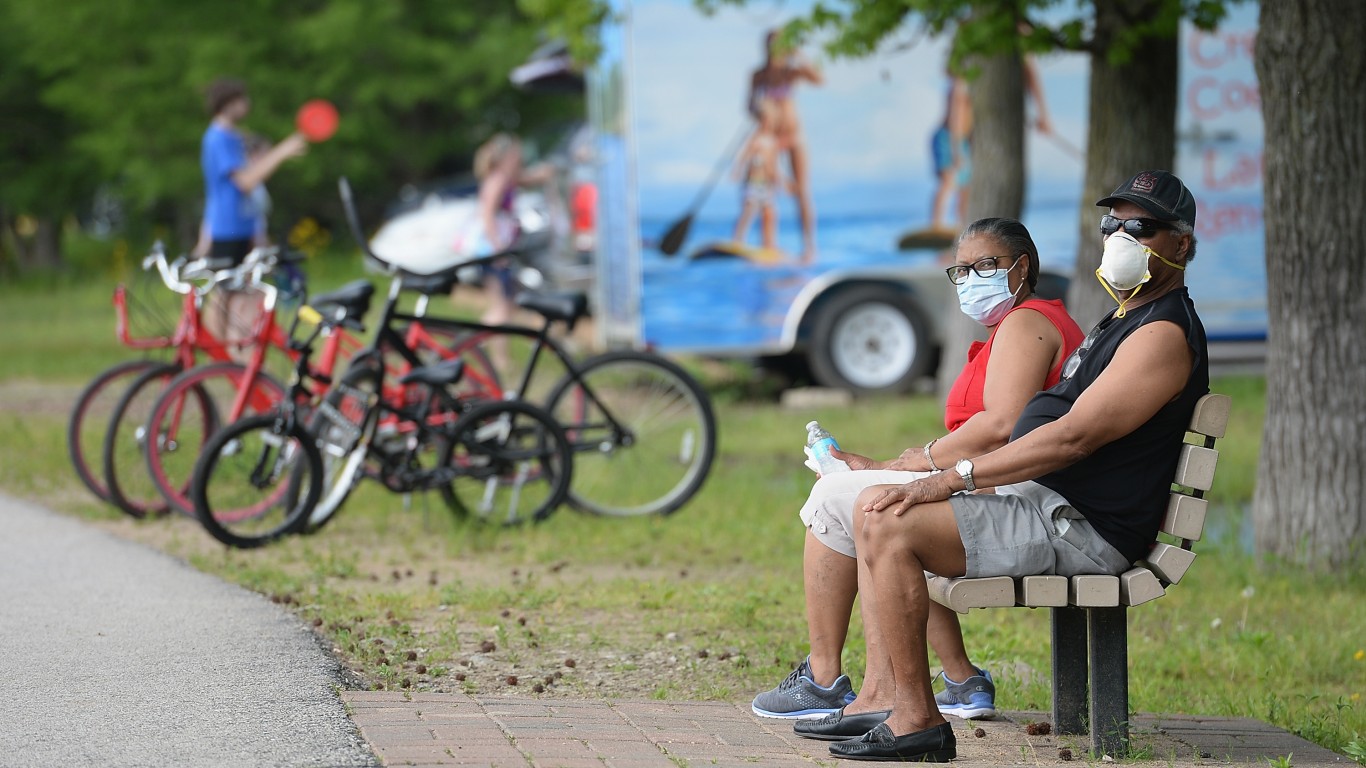
Published:
Last Updated:

It has been about two months since stay-at-home orders began to expire and states began the gradual reopening of their economies. Reports of surges of new coronavirus cases in several states that opened early soon followed. Some states are even reporting the highest ever levels of new daily COVID-19 cases.
24/7 Wall St. reviewed data on COVID-19 confirmed cases since May 14, by which point many states had already entered phase 1 of reopening. There are 18 states where the number of new confirmed cases has at least doubled over the last month.
Health officials are warning that people are not wearing masks when outside and not staying at least 6 feet away from other people.
Differences in how severe early outbreaks were might explain how the relaxation of restrictions impacted the spread of the coronavirus, according to Dr. Mark Siedner, an epidemiologist and associate professor at Harvard Medical School. People in places that reported outbreaks early in the pandemic appear to be practicing the most caution now, while the opposite is true in places that were not overwhelmed by outbreak.
Until the end of May, there was a strong downward trend in new cases across the country, according to Siedner. Then, states started opening up and the numbers of new cases began spiking, he noted. In some states, they even quadrupled. “What we found is that states that never had it really bad like New York are doing worse now,” Siedner said.
For example, in Arkansas, which until May 12 was the state with the 10th lowest number of COVID-19 cases per capita, there was a surge of 268% in the total number of coronavirus cases between May 14 and June 22, the second largest increase in cumulative cases of any state in the country.
As of June 22, nearly 2.3 million cases of COVID-19 had been reported across the country. The U.S. has about 700 confirmed cases per 100,000 residents, yet in four states that share is more than twice as high — these are the states with the highest number of coronavirus cases per capita.
Click here for the 18 states where cases have at least doubled over the last month.
Methodology
To determine the states where the total number of coronavirus cases has more than doubled in the last month — approximately since states began loosening restrictions on businesses and social gatherings — 24/7 Wall St. reviewed data on COVID-19 confirmed cases since May 14, two weeks after many states had entered phase 1 of reopening. Two weeks is considered a key measure of community spread as it is the upper limit of the incubation period for the virus.
Data on the total number of coronavirus cases and related deaths came from the Centers for Disease Control and Prevention as well as from state and local health departments. The number of COVID-19 tests every state has conducted as of June 22 also came from state and local health departments. We calculated the confirmed COVID-19 related deaths for every 100,000 people using one-year population data from the U.S. Census Bureau’s 2018 American Community Survey.

18. Nevada
> Total population: 3,034,392
> Increase of COVID-19 confirmed cases May 14 – June 22: 105.0% (from 6,604 to 13,535 total cases)
> Tests completed as of June 22: 20,967 per 100,000 people — 12th highest (280,618 total tests)
> Positive test rate: 4.8% — 15th lowest
> Cumulative COVID-19 deaths as of June 22: 16 per 100,000 — 25th highest (total: 489)
There has been a spike in daily coronavirus cases in Nevada since at least the beginning of June, about two weeks after restrictions on some businesses were lifted. The stay-at-home order expired on May 15, and some restrictions had already been lifted even before. Salons and tattoo parlors opened at the end of May. So did pools, museums, zoos, malls, bowling alleys, movie theaters, but with reduced capacity. The Nevada economy’s lifeblood, the gaming industry, reopened on June 4.
Just recently, the state had its worst two days since the virus was first confirmed in the state. There were 462 new coronavirus cases on June 23, the most in a single day in the state so far. Three days earlier, Nevada reported 452 new cases in a day, the second most in a day.
[in-text-ad]
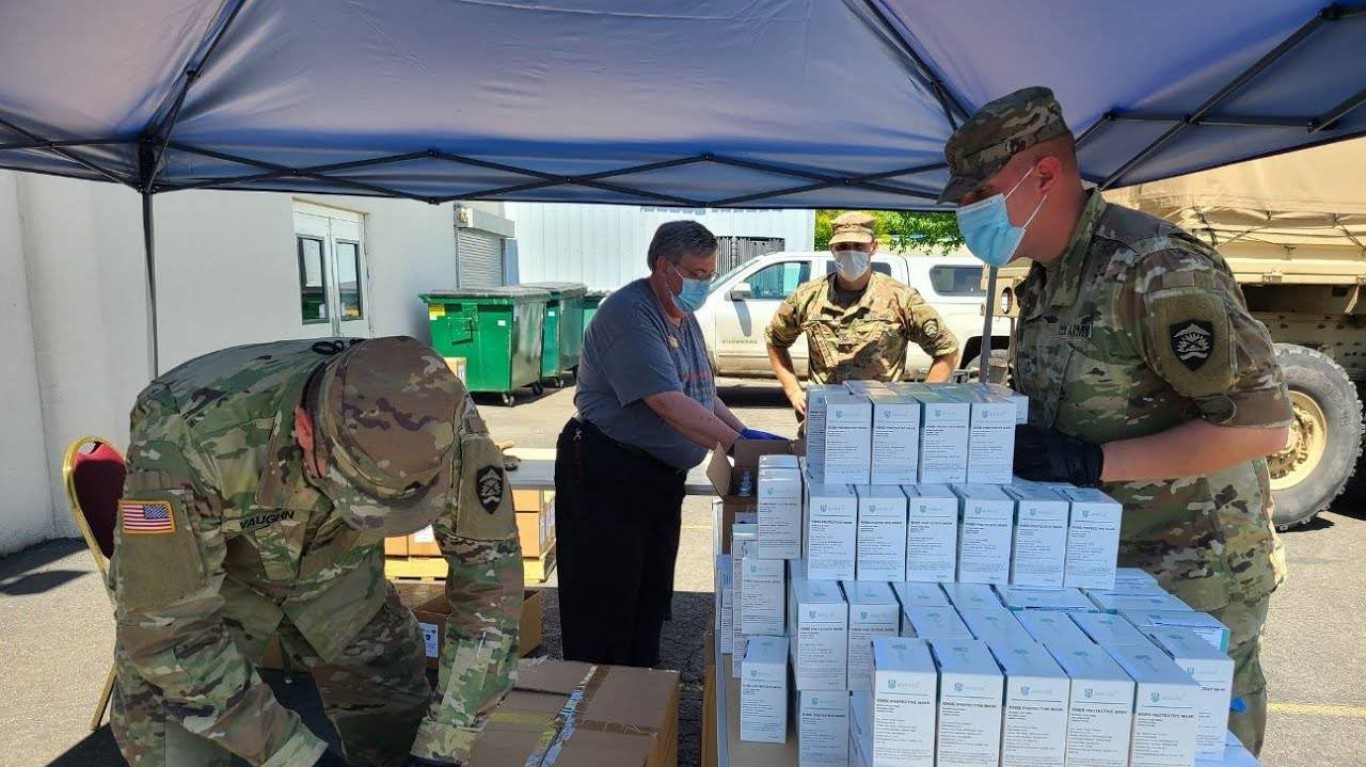
17. Oregon
> Total population: 4,190,713
> Increase of COVID-19 confirmed cases May 14 – June 22: 107.9% (from 3,407 to 7,083 total cases)
> Tests completed as of June 22: 5,234 per 100,000 people — 25th lowest (206,381 total tests)
> Positive test rate: 3.4% — 11th lowest
> Cumulative COVID-19 deaths as of June 22: 5 per 100,000 — 5th lowest (total: 192)
Though a stay-at-home order is in effect until further notice, counties can lift restrictions when they meet certain requirements, and many already have. At the beginning of June, some counties started allowing gatherings of 50 people indoors and 100 people outdoors, provided they follow social distancing rules, and extended curfews for restaurants until midnight. Movie theaters and large venues expanded their occupancy to up to 250 people then as well.
There have been small upticks in coronavirus cases in certain places since counties loosened their restrictions, and the state has put further reopening plans on hold.
16. Mississippi
> Total population: 2,986,530
> Increase of COVID-19 confirmed cases May 14 – June 22: 112.6% (from 10,483 to 22,287 total cases)
> Tests completed as of June 22: 2,406 per 100,000 people — 15th lowest (253,098 total tests)
> Positive test rate: 8.8% — 15th highest
> Cumulative COVID-19 deaths as of June 22: 33 per 100,000 — 13th highest (total: 978)
Mississippi’s shelter-in-place order expired on April 27. Shortly after, retail businesses and restaurants were allowed to open at limited capacity. On June 17, less than a month since restrictions on more businesses and gatherings were gradually lifted, Mississippi reported its second largest spike in COVID-19 cases. Many new cases were linked to fraternity and sorority parties. Health officials say this is largely due to people not following basic safety guidelines like wearing masks and not keeping 6 feet distance.
In addition to the number of coronavirus cases doubling since May 14, Mississippi’s total number of deaths related to COVID-19 also doubled — from 480 (or 16 per 100,000) on May 14 to 978 (or 33 per 100,000) on June 22, the ninth highest increase in the U.S.

15. Tennessee
> Total population: 6,770,010
> Increase of COVID-19 confirmed cases May 14 – June 22: 112.9% (from 16,699 to 35,553 total cases)
> Tests completed as of June 22: 12,472 per 100,000 people — 20th highest (699,854 total tests)
> Positive test rate: 5.1% — 16th lowest
> Cumulative COVID-19 deaths as of June 22: 8 per 100,000 — 12th lowest (total: 531)
Tennessee’s stay-at-home order expired on April 30. Many businesses were then allowed to open, including restaurants with limited capacity. Retail stores reopened around the same time as well. On June 19, Tennessee reported its biggest single-day increase in COVID-19 cases since the first cases were confirmed in March. However, the state is now including probable cases in its total number, which may help explain the spike.
Tennessee has prioritized testing for the coronavirus. The state has one of the highest test rates in the country — at more than 12,000 tests per 100,000 people — and one of the lowest positive rates. About 5% of tests come back positive, lower than the national average of 7%. All nursing homes in Tennessee are required to test their residents by June 30.
[in-text-ad-2]

14. Oklahoma
> Total population: 3,943,079
> Increase of COVID-19 confirmed cases May 14 – June 22: 116.3% (from 4,962 to 10,733 total cases)
> Tests completed as of June 22: N/A
> Positive test rate: N/A
> Cumulative COVID-19 deaths as of June 22: 9 per 100,000 — 16th lowest (total: 369)
New coronavirus cases in Oklahoma started to drop at the end of May, but now spikes are being reported across the state. Oklahoma, which never issued a statewide stay-at-home order except for the most vulnerable people, reported 352 new cases on June 19, one day after a record 450 new cases the day before. The previous record was 259 new cases, and that was set on June 18. Some restrictions on salons, restaurants, movie theaters, gyms, and other businesses where people can be in close proximity to each other were lifted as early as May 1.
Though Oklahoma has experienced a 116% increase in COVID-19 confirmed cases since mid-May, the increase of coronavirus-related deaths has been much smaller, at 30%, the 10th smallest increase in the country.

13. Virginia
> Total population: 8,517,685
> Increase of COVID-19 confirmed cases May 14 – June 22: 120.9% (from 26,469 to 58,465 total cases)
> Tests completed as of June 22: 11,367 per 100,000 people — 21st highest (555,607 total tests)
> Positive test rate: 10.5% — 11th highest
> Cumulative COVID-19 deaths as of June 22: 19 per 100,000 — 21st highest (total: 1,620)
New daily coronavirus cases in Virginia peaked on May 26, with 1,615. A day later the state mandated face masks in public. Virginia reported the highest number of deaths on May 28, at 57. Though the spread of new cases has slowed down, the total number of COVID-19 cases increased about 120% between May 14 and June 22.
The state will enter phase 3 of reopening on July 1, Gov. Ralph Northam announced on June 23. In phase 3, the limit on social gatherings will be raised to 250 from 50. Restaurants and retail businesses will be permitted to operate at full capacity. Northern Virginia entered phase 2 of reopening on June 12 and the rest of the state reached that phase a week earlier.
[in-text-ad]
12. Wisconsin
> Total population: 5,813,568
> Increase of COVID-19 confirmed cases May 14 – June 22: 122.3% (from 11,275 to 25,068 total cases)
> Tests completed as of June 22: 16,315 per 100,000 people — 15th highest (491,702 total tests)
> Positive test rate: 5.1% — 17th lowest
> Cumulative COVID-19 deaths as of June 22: 13 per 100,000 — 21st lowest (total: 745)
A spike of new coronavirus cases in Wisconsin was reported as early as May 28, only two weeks after the state’s sudden reopening. The reopening followed a decision by the Wisconsin Supreme Court on May 13 that struck down the state’s stay-at-home order. All restrictions were then lifted. Some districts imposed their own stay-at-home orders, though most lapsed in May and the beginning of June. The number of new COVID-19 confirmed cases a day has been increasing since.
On June 18, Wisconsin reported 422 new cases, the highest number of new confirmed cases in over two weeks.

11. Florida
> Total population: 21,299,325
> Increase of COVID-19 confirmed cases May 14 – June 22: 131.9% (from 43,210 to 100,217 total cases)
> Tests completed as of June 22: 12,638 per 100,000 people — 19th highest (1,618,540 total tests)
> Positive test rate: 6.2% — 24th lowest
> Cumulative COVID-19 deaths as of June 22: 15 per 100,000 — 24th lowest (total: 3,173)
Florida’s stay-at-home order expired on May 4, as the Sunshine State became one of the first to reopen. Beaches reopened for essential activities in parts of the state on April 17. Retail stores and restaurants in all but the most populous counties reopened at 25% capacity at the end of April. More restrictions have been eased since then, and the number of new COVID-19 cases has been spiking.
June 22 was the 20th straight day with new cases near or over 1,000 per day. On June 18, the state set a record of 3,207 new cases in a single day, up from the previous record of 2,783 cases set two days earlier. Gov. Ron DeSantis has ruled out closing businesses and enacting a new stay-at-home order again.
10. Wyoming
> Total population: 577,737
> Increase of COVID-19 confirmed cases May 14 – June 22: 132.5% (from 529 to 1,230 total cases)
> Tests completed as of June 22: 505 per 100,000 people — 4th lowest (36,228 total tests)
> Positive test rate: 3.4% — 9th lowest
> Cumulative COVID-19 deaths as of June 22: 3 per 100,000 — 4th lowest (total: 20)
Wyoming is among a handful of states that never issued a statewide stay-at-home order. Gyms, barbershops, hair salons, and other personal care services businesses reopened on May 1 with limits on the number of customers in a facility. Outdoor gatherings of up to 250 people have been allowed since June 1, though people must practice social distancing.
Wyoming is now seeing a statewide spike of new COVID-19 cases. A recent spike in Uinta County was attributed to a large social gathering of young people who were not following social distancing guidelines. In general, according to local health officials, many people are not wearing masks or practicing social distancing as they should be.
[in-text-ad-2]

9. Minnesota
> Total population: 5,611,179
> Increase of COVID-19 confirmed cases May 14 – June 22: 147.3% (from 13,435 to 33,227 total cases)
> Tests completed as of June 22: 8,492 per 100,000 people — 24th highest (513,137 total tests)
> Positive test rate: 6.5% — 25th highest
> Cumulative COVID-19 deaths as of June 22: 25 per 100,000 — 17th highest (total: 1,384)
Minnesota entered phase 3 of its reopening plan on June 10, allowing many businesses to increase occupancy. In June, the state has been seeing a wave pattern of new COVID-19 cases with days of decline followed by days of increase. Overall, the number of total coronavirus cases has jumped by 147% between May 14 and June 22. The number of total coronavirus-related deaths has also more than doubled in the same period, from 663 to 1,384.
Some business owners have been very unhappy with the governor’s executive orders intended to contain the coronavirus. A boxing gym, a yoga studio and a small business coalition filed suit challenging the executive orders. Gov. Tim Walz and Attorney General Keith Ellison, both Democrats, have asked a county court to dismiss the lawsuit. A hearing is set for July 16.
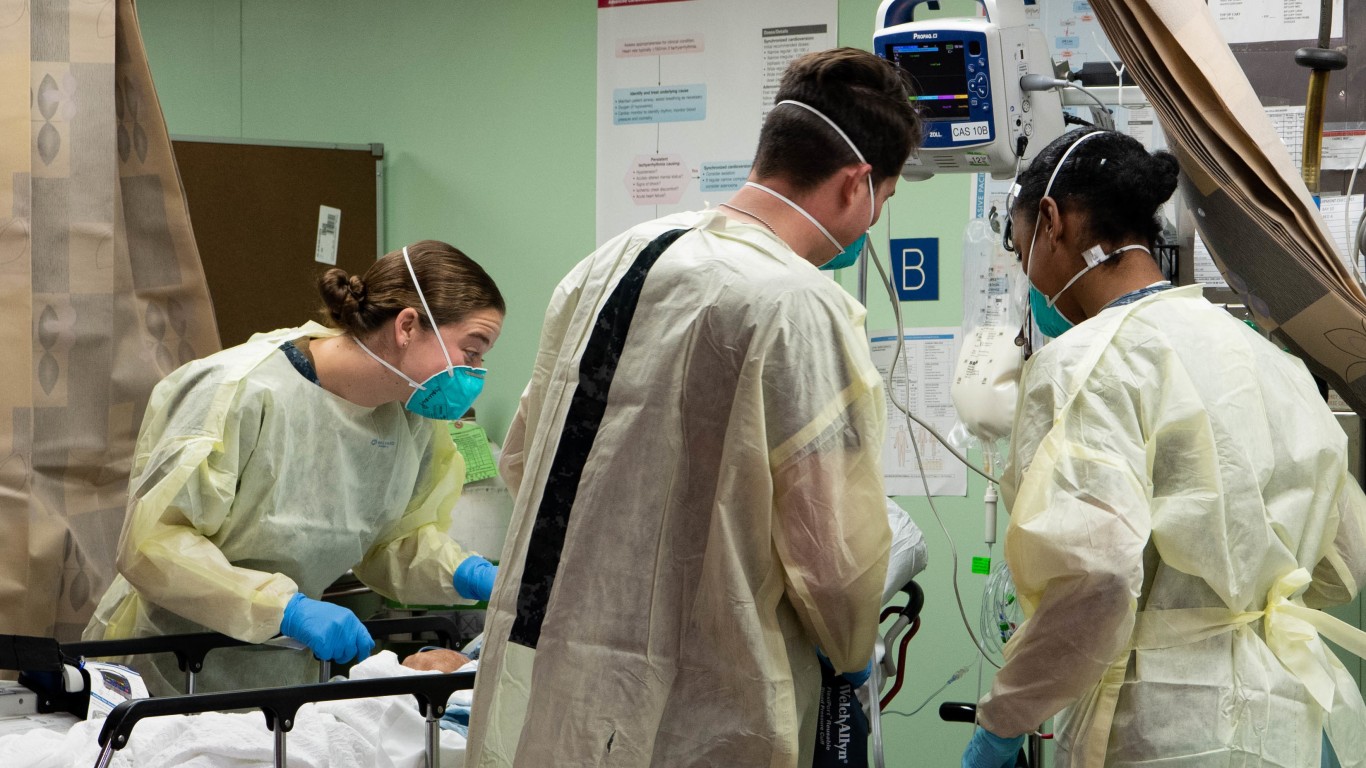
8. California
> Total population: 39,557,045
> Increase of COVID-19 confirmed cases May 14 – June 22: 150.3% (from 71,141 to 178,054 total cases)
> Tests completed as of June 22: 95,494 per 100,000 people — 3rd highest (3,411,686 total tests)
> Positive test rate: 5.2% — 19th lowest
> Cumulative COVID-19 deaths as of June 22: 14 per 100,000 — 23rd lowest (total: 5,515)
California was the first state to announce statewide restrictions on movement and businesses due to the coronavirus. The state’s stay-at-home order has no set end date, though easing of restrictions began in early May. The state is currently in phase 2 of its four-phase reopening, which started on May 8. California is now reporting record spikes in new coronavirus cases.
On June 18, the state reported for the first time more than 4,000 new cases in a single day. Just four days later, California reported its biggest daily increase, with 5,019 confirmed coronavirus cases.
To slow the spread of VOID-19 again, Californians are now required to wear face coverings in public places. It’s unclear if the state has plans to slow the reopening of the economy due to the new spikes in coronavirus cases.
[in-text-ad]
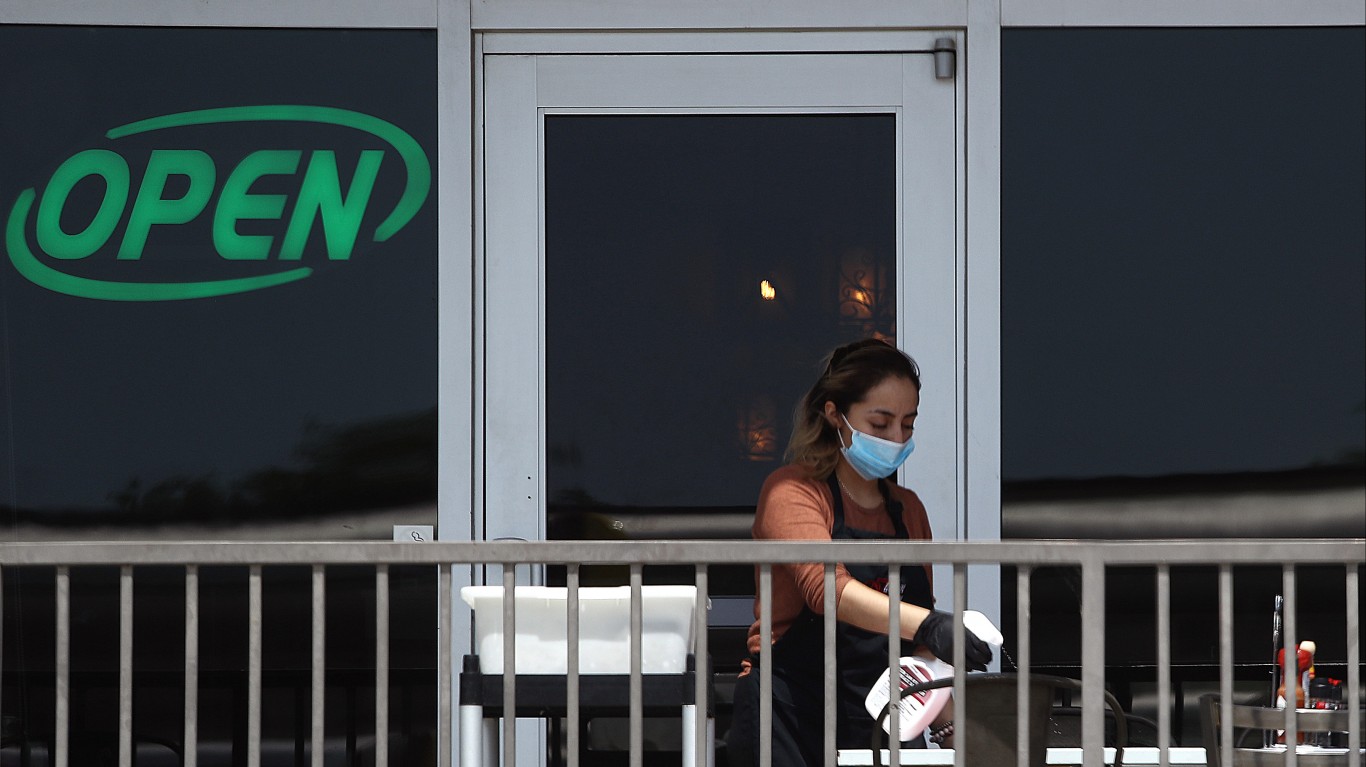
7. Texas
> Total population: 28,701,845
> Increase of COVID-19 confirmed cases May 14 – June 22: 162.0% (from 43,851 to 114,881 total cases)
> Tests completed as of June 22: 3,916 per 100,000 people — 21st lowest (1,549,009 total tests)
> Positive test rate: 7.4% — 22nd highest
> Cumulative COVID-19 deaths as of June 22: 8 per 100,000 — 11th lowest (total: 2,192)
Texas’ stay-at-home order expired on April 30. Many businesses, including restaurants, retailers, movie theaters, and malls, were allowed to reopen with limited capacity in early May. Texas is now among several states reporting record numbers of new cases of COVID-19. In the time between May 14 and June 22, the number of new cases has jumped by 162%.
Gov. Greg Abbott recently announced that despite the increase of hospitalizations and infections, there are no plans to shut down businesses again or to restrict services. Instead, he urged people to wear masks, which is not required, and to continue practicing physical distancing.

6. Utah
> Total population: 3,161,105
> Increase of COVID-19 confirmed cases May 14 – June 22: 165.3% (from 6,749 to 17,906 total cases)
> Tests completed as of June 22: 1,043 per 100,000 people — 7th lowest (299,312 total tests)
> Positive test rate: 6.0% — 22nd lowest
> Cumulative COVID-19 deaths as of June 22: 5 per 100,000 — 7th lowest (total: 158)
Utah never issued a statewide stay-at-home order, and the stay safe, stay home directive expired on May 1. In-restaurant dining, gyms, and salons have been open, and gatherings of up to 20 people were allowed as early as the beginning of May.
On June 18, Utah reported 495 cases of COVID-19, marking three weeks of significant daily increases. This was the second-highest daily increase in Utah since in mid-March, when the first case was confirmed in the state. On June 22, Utah reported 444 new cases in a single day, the 26th straight day with more than 200 daily new cases. Dr. Angela Dunn, the state epidemiologist, warned recently that if the average number of new daily coronavirus cases does not go down, the state may have to completely shut down.
5. Alabama
> Total population: 4,887,871
> Increase of COVID-19 confirmed cases May 14 – June 22: 170.5% (from 11,101 to 30,031 total cases)
> Tests completed as of June 22: 1,784 per 100,000 people — 11th lowest (348,687 total tests)
> Positive test rate: 8.6% — 17th highest
> Cumulative COVID-19 deaths as of June 22: 17 per 100,000 — 23rd highest (total: 831)
Eleven of the 12 days with the highest number of new coronavirus cases in Alabama were in June, according to state health officials. In mid-June, Alabama had the second highest number of new cases per capita in the country, according to the Associated Press.
Health officials worry that underlying health conditions that are more prevalent in the South are a major concern. Dr. Selwyn Vickers, dean of the University of Alabama at Birmingham School of Medicine, pointed to high rates of diabetes, kidney disease, and heart disease in Alabama. Doctors have learned that for patients with these conditions COVID-19 is more likely to become fatal. The number of deaths between May 14 and June 22 has increased by 76%, from 473 to 831.
[in-text-ad-2]

4. South Carolina
> Total population: 5,084,127
> Increase of COVID-19 confirmed cases May 14 – June 22: 213.4% (from 8,189 to 25,666 total cases)
> Tests completed as of June 22: N/A
> Positive test rate: N/A
> Cumulative COVID-19 deaths as of June 22: 13 per 100,000 — 22nd lowest (total: 659)
Like its northern neighbor, South Carolina saw COVID-19 cases growing rapidly in June. On June 23, state epidemiologist Dr. Linda Bell said that 42% of the state’s entire COVID-19 cases were diagnosed in the previous two weeks. “This is a very, very troubling trend, and it tells us that enough people are not taking this pandemic seriously enough and adopting the measures that we’ve been recommending,” Bell said.
The state confirmed 890 new cases on June 23. The state also reported 824 people are in hospital with coronavirus or suspected coronavirus, the highest number yet recorded in the Palmetto State. The state’s capital, Columbia, now requires face masks for all residents when in public. There is a $25 fine for violators, though it is not clear if the rule will be strictly enforced. Another large city, Greenville, has a similar rule.

3. North Carolina
> Total population: 10,383,620
> Increase of COVID-19 confirmed cases May 14 – June 22: 224.7% (from 16,507 to 53,605 total cases)
> Tests completed as of June 22: 24,959 per 100,000 people — 10th highest (757,345 total tests)
> Positive test rate: 7.1% — 24th highest
> Cumulative COVID-19 deaths as of June 22: 12 per 100,000 — 19th lowest (total: 1,223)
As North Carolina considers additional reopening steps, health officials are worried about the rise in coronavirus cases. In mid-June, about 10% of COVID-19 tests were coming back positive. Experts were hoping to see that number closer to 5%. The number of coronavirus cases surged 225% between May 14 and June 22 from just over 16,500 to nearly 54,000.
Charlotte Mayor Vi Lyles is among a group of officials urging Gov. Roy Cooper to require masks statewide. Some cities and counties already mandate their use. North Carolina is currently in what it calls phase 2. Large gatherings are allowed, and restaurants can offer indoor dining at reduced capacity.
[in-text-ad]
2. Arkansas
> Total population: 3,013,825
> Increase of COVID-19 confirmed cases May 14 – June 22: 268.4% (from 4,366 to 16,083 total cases)
> Tests completed as of June 22: 18,046 per 100,000 people — 14th highest (256,339 total tests)
> Positive test rate: 6.3% — 25th lowest
> Cumulative COVID-19 deaths as of June 22: 8 per 100,000 — 9th lowest (total: 227)
One of the few states to never issue a stay-at-home order, Arkansas continues to report growing COVID-19 cases and hospitalizations. The state reported 595 new cases and 10 deaths on June 23. Gov. Asa Hutchinson said the number of positive cases is now higher than what was projected by the University of Arkansas for Medical Sciences on June 17.
Hutchinson is counting on citizens to voluntarily social distance and wear masks. On June 12, the state reported 731 new coronavirus cases in one day, the largest daily jump in the state since the outbreak began. The total number of coronavirus cases has nearly quadrupled between May 14 and June 22, rising from 4,366 to 16,083. The numbers of total COVID-19-related deaths has more than doubled — from 98 on May 14 to 227 on June 22.
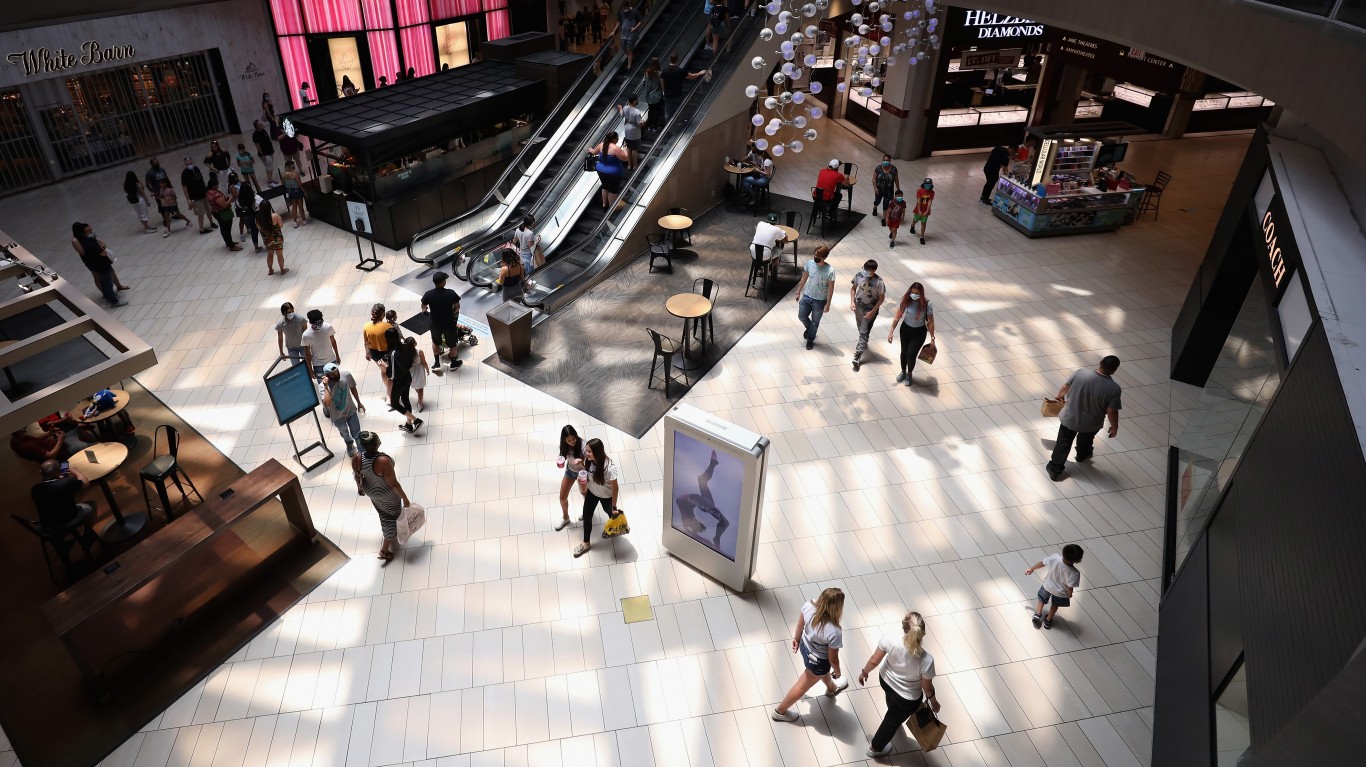
1. Arizona
> Total population: 7,171,646
> Increase of COVID-19 confirmed cases May 14 – June 22: 330.7% (from 12,674 to 54,586 total cases)
> Tests completed as of June 22: 68,564 per 100,000 people — 6th highest (429,418 total tests)
> Positive test rate: 12.7% — 4th highest
> Cumulative COVID-19 deaths as of June 22: 19 per 100,000 — 22nd highest (total: 1,342)
Arizona has become the top hotspot for new COVID-19 infections. The state has so far confirmed nearly 60,000 cases, and health experts say the trends are worrisome. Between May 14 and June 22, the total number of COVID-19 confirmed cases surged 330%, more than in any other state. As of June 23, 84% of the state’s intensive care unit beds were occupied, according to the Arizona Department of Health Services.
After the state lifted its stay-at-home order on May 15, Gov. Doug Ducey blocked local jurisdictions from requiring residents to wear face masks. As cases have steadily risen, however, Ducey reversed course and was one of the few attendees at Trump’s rally to wear a protective mask. Still, there is no statewide requirement to wear masks, despite the CDC’s recommendations. Epidemiologists are particularly alarmed by the large numbers of young people catching the virus. About 60% of the new cases in Arizona are in people under the age of 44.
If you’re one of the over 4 Million Americans set to retire this year, you may want to pay attention.
Finding a financial advisor who puts your interest first can be the difference between a rich retirement and barely getting by, and today it’s easier than ever. SmartAsset’s free tool matches you with up to three fiduciary financial advisors that serve your area in minutes. Each advisor has been carefully vetted, and must act in your best interests. Start your search now.
Don’t waste another minute; get started right here and help your retirement dreams become a retirement reality.
Thank you for reading! Have some feedback for us?
Contact the 24/7 Wall St. editorial team.